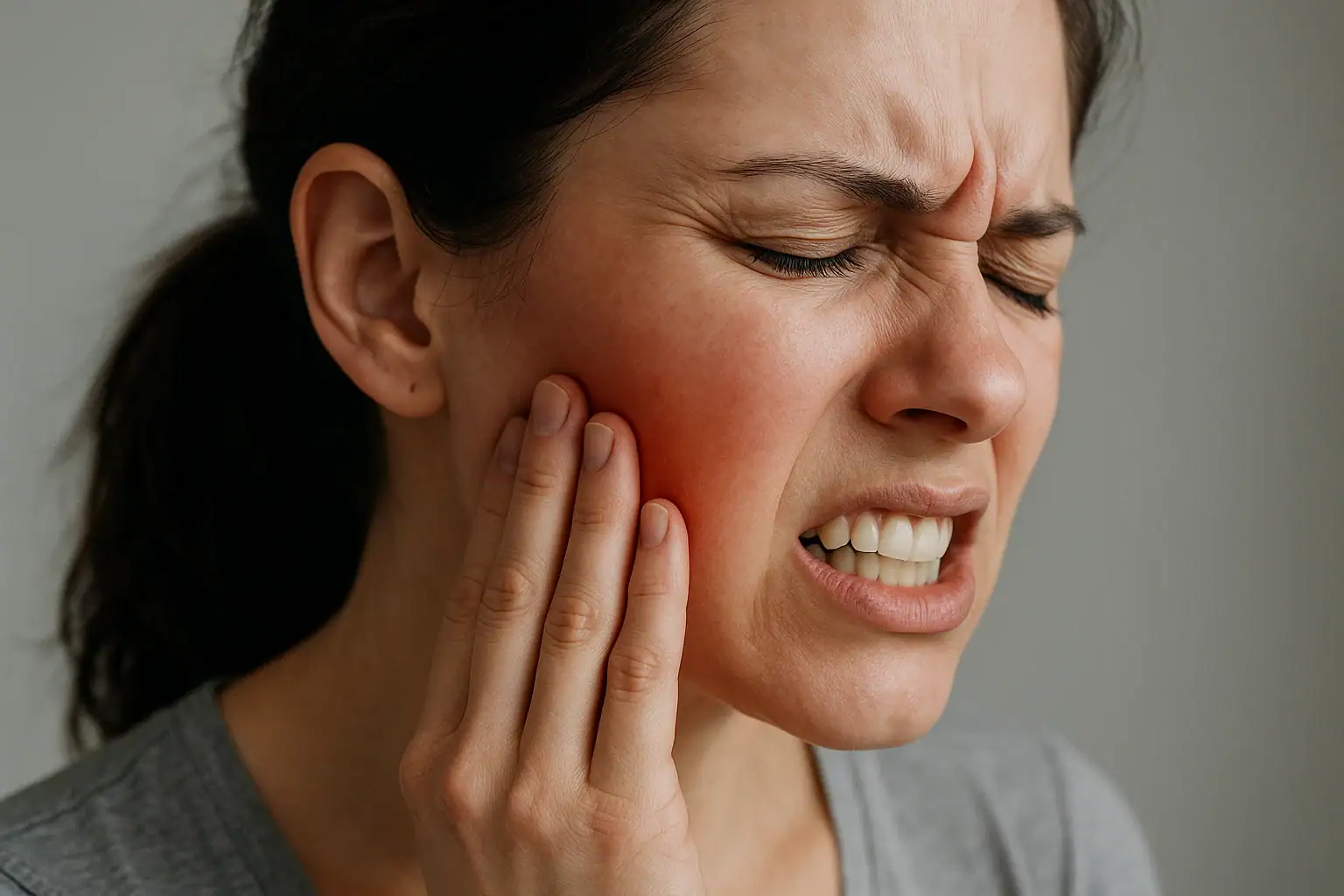Menu
Free Consultation

Jaw pain that starts as a dull ache in the morning and intensifies through the day is often more than just stress or fatigue—it can be a sign of teeth grinding (bruxism) or temporomandibular joint (TMJ) dysfunction. According to the American Academy of Oral and Maxillofacial Surgeons, TMJ disorders affect an estimated 10 million Americans, and bruxism impacts nearly one in every five adults. The overlap between these two conditions is significant: chronic clenching and grinding place excessive stress on the TMJ, the hinge that connects your jaw to your skull, leading to inflammation, headaches, facial soreness, and restricted movement.
While professional dental evaluation is crucial for proper diagnosis, there are several dentist-approved home care strategies that can relieve discomfort, improve jaw mobility, and prevent long-term complications. This guide explores everything you need to know about TMJ pain relief, the connection between bruxism and jaw disorders, and safe exercises you can do at home to relax your jaw muscles and protect your teeth.
The temporomandibular joint (TMJ) is one of the most complex joints in the human body. Located just in front of each ear, it connects the lower jaw (mandible) to the temporal bone of the skull. The TMJ allows three types of motion:
When these motions are disrupted due to overuse, muscle tension, or misalignment, the result is temporomandibular joint disorder (TMD). Common symptoms include:
Bruxism refers to the involuntary clenching or grinding of teeth, often during sleep. The pressure exerted during grinding can exceed 250 pounds per square inch—far more than the force needed to chew food—placing enormous strain on the jaw muscles and TMJ.
When jaw muscles like the masseter and temporalis are continuously engaged, microscopic tears and inflammation occur, leading to morning stiffness and dull, radiating facial pain.
Excessive grinding can shift the cushioning disc that separates the jawbone from the skull, producing the characteristic click or pop sound. Repeated displacement leads to chronic pain and restricted motion.
Over time, grinding wears down enamel and alters bite alignment. This imbalance worsens joint stress, perpetuating a pain-spasm-pain cycle.
Bruxism is often stress-induced. Elevated cortisol levels increase muscle tension, making nighttime clenching worse. The persistent strain triggers inflammation, which then amplifies pain sensitivity through nerve pathways.
Several factors heighten your risk for developing both bruxism and TMJ dysfunction:
| Risk Factor | Impact |
|---|---|
| Stress & Anxiety | Triggers unconscious clenching or grinding. |
| Malocclusion (bad bite) | Causes uneven pressure distribution across the jaw. |
| Sleep Disorders | Bruxism commonly co-occurs with sleep apnea. |
| Arthritis or Joint Degeneration | Erodes cartilage and reduces joint cushioning. |
| Hormonal Fluctuations | Women are twice as likely to develop TMD due to estrogen-linked ligament laxity. |
| Postural Imbalance | Forward head posture strains jaw alignment and neck muscles. |
A comprehensive dental exam is the best way to differentiate TMJ disorder from other conditions like sinus infections or ear issues. A dentist-approved TMJ evaluation usually includes:
Before exploring exercises, it’s vital to address underlying habits and environmental factors that aggravate TMJ pain.
Alternate heat and cold for best results—heat loosens tight muscles, while cold minimizes swelling.
Stress reduction is central to bruxism management.
Postural correction reduces neck and jaw pressure.
Clinical studies show that guided physical therapy and stretching can significantly alleviate TMJ discomfort and improve jaw range of motion. The following exercises are recommended by dental and physiotherapy associations for safe home practice.
⚠️ Important: Always perform these exercises gently. If pain intensifies, stop and consult your dentist or physiotherapist.
Purpose: Reduce baseline muscle tension and train proper jaw resting posture.
Steps:
This helps retrain the jaw to remain relaxed rather than clenched unconsciously.
Purpose: Strengthen TMJ muscles and restore alignment.
Partial Opening:
Full Opening:
Purpose: Enhance smooth motion and prevent deviation.
Steps:
Tip: Do this in front of a mirror to monitor symmetry.
Purpose: Correct head-forward posture and reduce neck tension contributing to TMJ strain.
Steps:
Purpose: Strengthen jaw muscles and stabilize the joint.
For Opening:
For Closing:
Repeat 5–6 times each direction.
Purpose: Improve coordination and joint stability.
Steps:
Purpose: Stretch lateral pterygoid muscles responsible for grinding motion.
Steps:
Purpose: Improve anterior mobility for chewing and speaking.
Steps:
While mild discomfort responds to home care, certain symptoms require prompt dental or medical evaluation:
If home management isn’t sufficient, dentists may recommend advanced interventions tailored to your condition’s severity.
Custom-made acrylic devices worn over teeth redistribute biting forces and prevent enamel wear. Studies show a 70% reduction in morning jaw pain within three months of consistent night-guard use.
Targeted physiotherapy improves joint mobility and reduces inflammation. Ultrasound or low-level laser therapy can accelerate healing by boosting blood flow to the joint capsule.
Botulinum toxin (Botox) injections temporarily relax overactive jaw muscles, reducing bruxism intensity by up to 60–80% in chronic cases. Effects typically last 3–6 months.
Correcting bite alignment with braces or reshaping enamel surfaces can resolve uneven stress on the TMJ.
Biofeedback, mindfulness, and cognitive-behavioral therapy (CBT) effectively reduce stress-related clenching behaviors and improve sleep quality.
In severe cases involving joint degeneration or disc displacement, minimally invasive arthrocentesis or arthroscopy may be indicated. Open surgery is rare and reserved for structural deformities.
Sustainable improvement comes from lifestyle balance. Integrate these long-term strategies into your daily routine:
| Habit | Why It Helps |
|---|---|
| Avoid resting chin on your hand | Prevents jaw misalignment and strain. |
| Limit gum chewing and hard foods | Reduces repetitive motion stress. |
| Maintain good sleep hygiene | Minimizes nighttime clenching. |
| Manage stress through mindfulness | Lowers cortisol and muscle tension. |
| Stay hydrated | Keeps joint cartilage lubricated. |
| Regular dental check-ups | Detect early wear and prevent progression. |
Clinical literature supports conservative, non-surgical care as first-line treatment for TMJ and bruxism-related pain. A 2024 systematic review in the Journal of Oral Rehabilitation found that exercise therapy and splint use improved function and pain scores in 80% of patients within eight weeks. Another 2025 Cochrane Review confirmed that combining physical therapy, behavioral modification, and occlusal guards provided better outcomes than medication alone.
1. How long does it take for TMJ pain to heal?
Mild TMJ pain can improve within 2–4 weeks of consistent exercises and stress management. Chronic cases may take several months, depending on joint damage and grinding intensity.
2. Are TMJ exercises safe to do daily?
Yes, provided movements are gentle and pain-free. Overexertion can worsen inflammation, so focus on consistency rather than force.
3. Do night guards really help with jaw pain?
Absolutely. Custom night guards reduce clenching pressure by distributing bite forces evenly, protecting teeth and joints.
4. Can bruxism cause headaches or ear pain?
Yes. The temporalis and masseter muscles radiate pain to temples and ears, often mimicking migraines or ear infections.
5. When should I see a dentist or specialist?
If pain persists beyond two weeks, if your jaw locks or clicks painfully, or if you notice significant tooth wear or facial asymmetry.
TMJ disorders and bruxism can transform everyday activities—eating, talking, even smiling—into painful challenges. Fortunately, most cases respond remarkably well to self-care, targeted exercises, and professional dental guidance. By combining dentist-approved home techniques with lifestyle adjustments, you can relax overworked muscles, reduce inflammation, and regain comfortable movement.
Your jaw is one of the hardest-working joints in the body—give it the care it deserves. If pain persists, consult a TMJ-specialized dentist or physiotherapist to tailor a treatment plan that restores balance to both your bite and your life.
